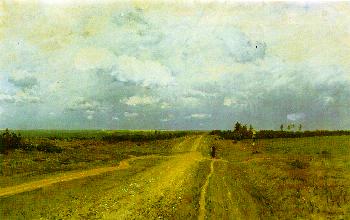
Oil on canvas, 79 x 123 cm. Tretyakov Gallery, Moscow.

 Levitan often combined his realistic vision with a strong message. In this
case, the desolation of the landscape echoes the message conveyed by the
road itself. The Vladimirka road is the road taken by the exiles to reach
Siberia. Levitan was probably making reference to his own exile, which
occurred in the same period. Like many political prisoners, he had been
evicted from Moscow because he was Jewish, and this experience would leave
a profound mark on the painter's soul. The sky and the fields are all part
of the symbolic message that Levitan wants to render through his painting.
Colors are dull and rather unattractive. Levitan chooses browns and dull
greens so that nothing would stand out; the sky is blue-gray, cloudy, and
unforgiving. There is no sun peeking from behind the clouds, as if the
painter wanted to say that there is little hope for those who would take
that road. The landscape is flat and, with the exception of the trees in
the background, has no other vegetation except some sparse yellowish grass.
The road appears to have no end. Perhaps Levitan is trying to say that
the prisoners are forever itinerants or that Russia is so vast that human beings
"vanish" in its unlimited space. There are no human figures, which
seems to be a characteristic feature of realistic landscapes of other painters
(Shishkin, for instance) and of Levitan himself. Actually, the tendency
to "de-humanize" compositions by excluding human figures would be a recurrent
feature in Levitan's work. [S.C.]
Levitan often combined his realistic vision with a strong message. In this
case, the desolation of the landscape echoes the message conveyed by the
road itself. The Vladimirka road is the road taken by the exiles to reach
Siberia. Levitan was probably making reference to his own exile, which
occurred in the same period. Like many political prisoners, he had been
evicted from Moscow because he was Jewish, and this experience would leave
a profound mark on the painter's soul. The sky and the fields are all part
of the symbolic message that Levitan wants to render through his painting.
Colors are dull and rather unattractive. Levitan chooses browns and dull
greens so that nothing would stand out; the sky is blue-gray, cloudy, and
unforgiving. There is no sun peeking from behind the clouds, as if the
painter wanted to say that there is little hope for those who would take
that road. The landscape is flat and, with the exception of the trees in
the background, has no other vegetation except some sparse yellowish grass.
The road appears to have no end. Perhaps Levitan is trying to say that
the prisoners are forever itinerants or that Russia is so vast that human beings
"vanish" in its unlimited space. There are no human figures, which
seems to be a characteristic feature of realistic landscapes of other painters
(Shishkin, for instance) and of Levitan himself. Actually, the tendency
to "de-humanize" compositions by excluding human figures would be a recurrent
feature in Levitan's work. [S.C.]
